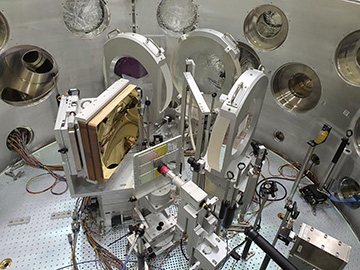
Researchers created high-intensity pulses using the petawatt laser (pictured) at the Center for Relativistic Laser Science (CoReLS) in the Republic of Korea. [Image: Chang Hee Nam, CoReLS]
Tighter focus in an adaptive-optics system led researchers at a Korean laboratory to break their own record for high laser intensity (Optica, doi: 10.1364/OPTICA.420520).
The team at the Center for Relativistic Laser Science (CoReLS) in Gwangju, South Korea, achieved a peak laser intensity of 1.1 (± 0.2) × 1023 W/cm2 with the laboratory’s 4-PW Ti:sapphire laser. The beam from that petawatt laser was focused down to a spot size of just 1.1 μm.
The center reported its previous record of laser intensity, 5 × 1022 W/cm2, two years ago (Opt. Express, doi: 10.1364/OE.27.020412).
Wavefront correction, tight focus
Best known for removing atmospheric “twinkle” from ground-based astronomical observations, adaptive optics has also made these high-intensity laser shots possible. From light generation to the near-field camera, the experimental beamline passes through a collection of correctors: partial reflection mirrors, deformable mirrors and wavefront sensors. The first deformable mirror in the sequence had a diameter of 100 mm and was part of a closed-loop system with a Shack-Hartmann wavefront sensor. The second deformable mirror was 310 mm in diameter and had 127 activators.
Inside the target chamber, an f/1.1 off-axis parabolic mirror with an effective focal length of 300 mm focused the high-power beam close to the diffraction limit, down to the tiny spot needed to achieve the record laser intensity. According to OSA Fellow Chang Hee Nam, CoReLS director and a physics professor at South Korea’s Gwangju Institute of Science and Technology, the 2019 set of experiments used an f/1.6 off-axis parabolic mirror, which did not focus the beam as tightly as the f/1.1 model.
It is “not simple” to focus a 28-cm-wide petawatt laser beam down to a width of just over 1 μm, Nam says. Using a high-precision six-axis mount with the parabolic mirror helped with the task, as did the cumulative years of experience on the CoReLS team, which has been running the 4-PW laser since 2014.
Next up: quantum electrodynamics

A laser–matter interaction chamber for proton acceleration, in which the focal intensity over 1023 W/cm2 was demonstrated by tightly focusing a multi-petawatt laser beam with an f/1.1 off-axis parabolic mirror. [Image: Chang Hee Nam, CoReLS]
CoReLS scientists will use the 1023 W/cm2 beam for studies of strong-field quantum electrodynamics (QED). The high-intensity laser beam is “a basic tool to explore the interactions of relativistic electrons and photons, or photon–photon scattering,” Nam says. The laser can accelerate electrons to GeV energy for investigating the scattering of GeV electrons, and the ultrahigh-intensity laser pulses can simulate the strong-field QED processes occurring in the universe in places like black holes and supernovae.
The Korean team is also aware of the worldwide competition for bigger and brighter lasers. “Other laboratories are chasing us in laser power and in laser intensity,” Nam says. “When we developed the 4-PW laser in 2016, it was the most powerful laser in the world—an outcome from the ultrahigh-power laser development for more than 10 years.” The laboratory Nam leads, CoReLS, is part of a larger scientific constellation, the Institute for Basic Science, funded by the South Korean government along the lines of the Max Planck Society’s many research laboratories in Germany.
